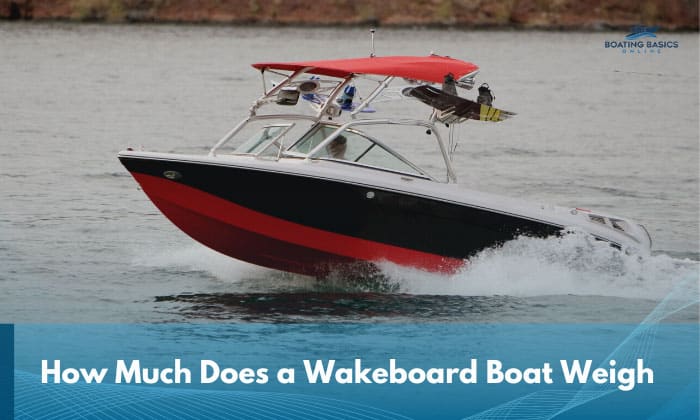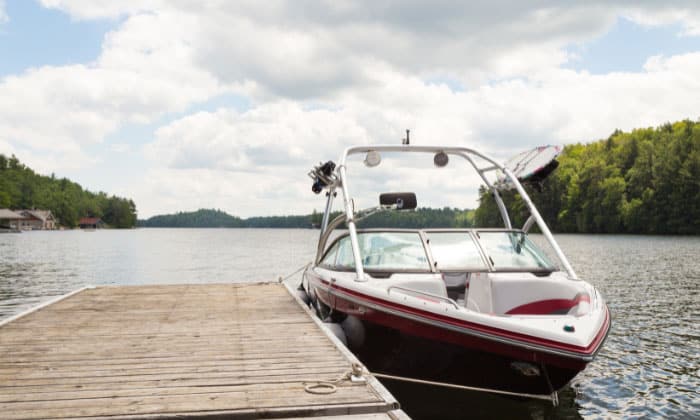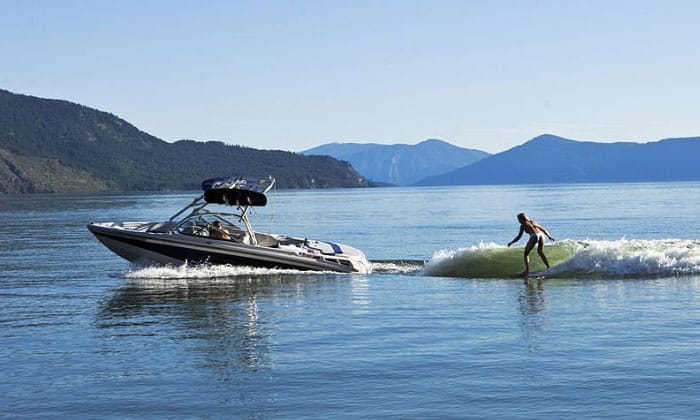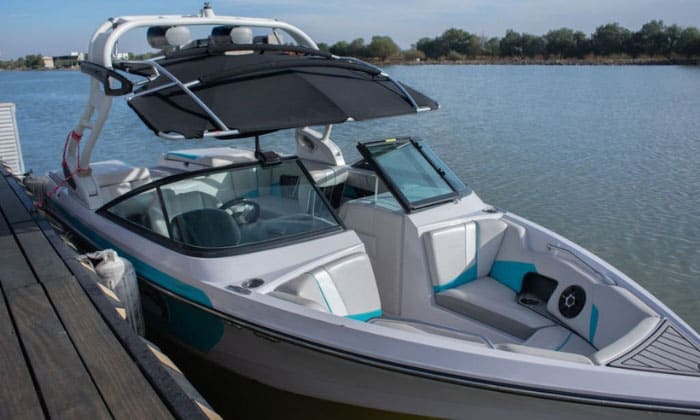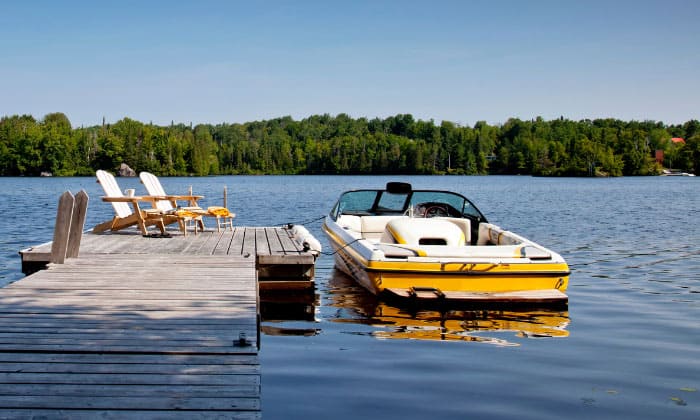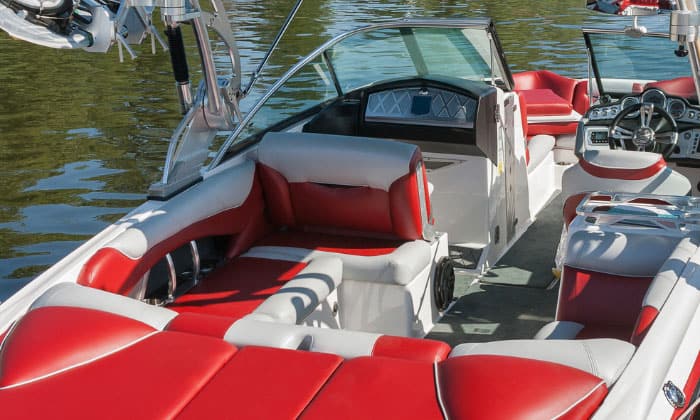It’s important to learn the weights of boats, mostly due to towing requirements. On the other hand, wake boat owners ask, “How much does a wakeboard boat weigh?” because they’re also concerned with performance and handling, particularly when adjusting the ballast system and getting the best wake shape.
The average boat weight range is between 2,000 pounds to 6,000 pounds. That applies to boats spanning 18 to 25 feet which encompass wake boats of all sizes, including hybrids.
Table of Contents
Typical Weights of Wakeboard Boats
The question, “How heavy are boats?” will always be difficult to answer with a single figure because a lot of factors affect boat weight. Wake boat weight fluctuates just as much since the said facets affect them, too, as proven by the following ranges I’ve researched.
- A small boat spanning 16 ft to 19 ft will typically fall under the lightweight category but take note that size isn’t the sole factor of wake boat weight. Lightweight wakeboard boats are those that have a weight range of 1,500 to a little over 2,500 pounds.
- A mid-weight boat overlaps with the average weight said above as it applies to your standard 20-foot boat. To be more precise, these boats weigh between 2,600 pounds to 5,000 pounds.
- In order for a wakeboard boat to be considered heavy, it should have a weight range of 5,100 pounds and above.
Another notable fact is that the Chaparral 30, which was considered the largest wake boat, has a declared dry weight of 8,200 pounds. Boat Test tested it, and they discovered that it actually weighs more, 9,015 pounds, to be exact.
That only proves that we can’t ever really limit these boats to a range, especially if we’re going to consider every wake boat that has ever been manufactured.
Wakeboard Boat Models and Their Weights
When we look at wakeboard models, it’s clear that most of the “classic” wake boats (meaning those that are made for optimal wakeboarding) rarely go over 25 feet. We only ever see deviations from the standard weight range if we start looking at outliers like hybrid wake boat/bowrider models or those that are larger than most for the most part.
Consider the following models, for example:
- The 18-foot 2023 HURRICANE 185 weighs 2,150 pounds.
- The 19-foot AR190 by Yamaha tops at 2,441 pounds.
- The 22-foot Malibu Wakesetter 22 LSV weighs approximately 5,100 pounds.
- The 26-foot Regal L26 Surf has a dry weight of 5,380 pounds.
- The 28-foot Regal LS9 weighs 7,600 pounds.
Notice how some of the longer and weightier models tend to be no longer pure wakeboard boats (but that’s not always the case!) The Regal L26 Surf and LS9 are both classed as hybrid bowrider/wake boats, and one of them uses an I/O.
An I/O motor isn’t exactly ideal for wakeboarding, and the bowrider hybrids incorporate them. Regals are particularly known for doing that, and many experienced wakeboarders can attest that they aren’t really ideal options.
Even so, we can’t deny that they’re still technically wakeboard boats.
Regarding Dry Weight
All of the weights mentioned above refer to each vessel’s dry weight (the boat’s weight upon manufacture). Boat dry weight will invariably be an important factor not only for trailering but also for ensuring that you’ll have an optimal wakeboarding experience.
After all, it determines how deeply the boat will sit in the water. More often than not, more weight means a bigger wake due to the amount of water it displaces. That ultimately impacts how you’re going to do proper weight distribution for your boat.
For your further reference, I’ve listed down 15 more models with their respective dry weights. I’ve made sure to include most of the top brands as well as some of the more obscure ones for a larger sample size.
I understand that most listing sites make wake boats synonymous with ski boats. This is why I only picked the ones that visibly have towers and checked their specifications.
Here they are as follows:
| Wakeboard Boat Model | Dry Weight |
| Super Air Nautique G23 | 6,000 pounds |
| Supra SL | 5,950 pounds |
| Centurion Ri245 | 5,700 pounds |
| MasterCraft XT22 | 5,485 pounds |
| Supreme ZS212 | 5,350 pounds |
| Heyday H22 | 5,188 pounds |
| Tige 20RZX | 4,975 pounds |
| Supra SR | 4,900 pounds |
| Moomba Mojo | 4,800 pounds |
| Moomba Max | 4,500 pounds |
| Four Winns HD3 Surf (hybrid) | 4,170 pounds |
| Sea Ray SPX 190 | 2,675 pounds |
| Tahoe T18 (hybrid) | 2,605 pounds |
| Yamaha Boats AR195 | 2,500 pounds |
| MasterCraft 19 Stars & Stripes | 2,200 pounds |
Factors Affecting Wakeboard Boat Weight
The average weight of a boat will naturally be affected by its hull material and integral components. These make up the dry weight.
Those made of aluminum will inevitably be lighter than those composed of fiberglass. As we all know, wake boats also have towers, which have an average weight of 250 pounds. Not to mention the ballast systems.
The ideal wake boat engine is an inboard one. Factoring in wakeboard boat dimensions, all the said components and amenities are already included in the dry weight.
Past dry weight, here are the other factors that will affect the wake boat’s weight:
- Every gear you bring along (including batteries)
- Fuel
- Passengers
- Water in the bilge
- Ballast weight (ranges between 1,000 to 5,000 pounds)
Determining the Actual Weight
Now, I get that you’re probably also curious about wake boats’ weight because you want to ensure that you’ll be able to pair your choice with the proper trailer.
First, let’s tackle why it’s important to look at the wake boat’s weight besides the heft of your actual wakeboard.
Why Does Wakeboard Boat Weight Matter?
Heavy wakeboard boats naturally produce the largest wakes. Once you decide to increase the boat’s weight by adding more ballast bags or adjusting the ballast system, that almost always means you want to increase the wake’s size as well. Performance-wise, that’s the sole factor why you should be mindful of wake boat weight.
Obviously, knowing the boat’s total weight guarantees safe trailering. Just look at the tools for trailer weight calculation online, and you’ll see that the first thing it will ask is the boat’s dry weight: https://venturetrailers.com/buying-guide/weight-calculator/
Common Items and Their Estimated Weights
The gross trailer weight (GTW) includes the weight of the trailer and all its cargo, including your boat. You’ll have to add these together to ensure that you’ll stay within safe towing limits.
It’s hard to account for extra gear because there’s a lot that can be personalized in most wake boats. What more if we add in the PFDs, tower speakers, additional safety equipment, entertainment devices, food and drink, and all your other personal stuff?
I’ve prepared a table for your easy reference:
| Additional Considerations | Average Weight |
| Trailer | 1,000 to 1,600 pounds |
| Fuel | 6 pounds per gallon |
| Gear | Varies a lot |
Capacity Calculation
You can feel free to use the calculator I’ve shared above or just look at the exact capacity printed on the trailer’s data plate. Besides those, you don’t have to complicate your trailer weight calculations.
Begin by getting the trailer’s curb or empty weight. Do this by driving your trailer on a public scale and making sure nothing’s on it. Once you get the exact figure, follow this formula:
Trailer’s GVWR – Trailer curb weight
For example: 5,000 pounds – 1,200 pounds = 3,800 pounds
That means 3,800 pounds is your safe payload capacity.
Frequently Asked Questions
How many passengers can my wakeboard carry?
Every boat has a passenger capacity plate, which you should always follow. It will tell you the maximum weight and number of passengers.
Take note that just because your boat’s capacity tells you that you can have a maximum of 6 passengers onboard doesn’t always mean that you can safely accommodate six adult people every time. Always look at the maximum weight capacity first.
What should I consider when towing a wakeboard boat?
It’s no different from any other boat. Make sure you’re not going over your weight capacity and know the exact weight of your boat. Inspect every vital component of the trailer before departing.
Always account for tongue weight, too, and the type of axle that may better accommodate your boat. After all, these factors ensure stability while trailering.
How do I know my car can pull my wakeboard boat?
Get your exact GTW (or GCW or Gross Combined Weight in some circles) that accounts for the weight of both the boat and trailer, with all the additional cargo considered.
Next, check your vehicle’s exact tow rating. It should be indicated as Gross Combined Weight Rating (GCWR). The GCW shouldn’t go past your vehicle’s GCWR.
Conclusion
Overall, when answering the question, “How much does a wakeboard boat weigh?” you clearly have to take the time to look at the specific weight of the wakeboard vessels you’re considering. This is the only way to get the most satisfactory answer.
In turn, you’ll be able to immediately know whether it will be appropriate for the wakeboarding experience you’re anticipating and confirm its correct towing requirements.

“My intention from the first day establishing Boating Basics Online is to provide as much help as possible for boaters who want to experience a first safe and convenient trip. So feel free to join us and share your beautiful journeys to the sea!”

